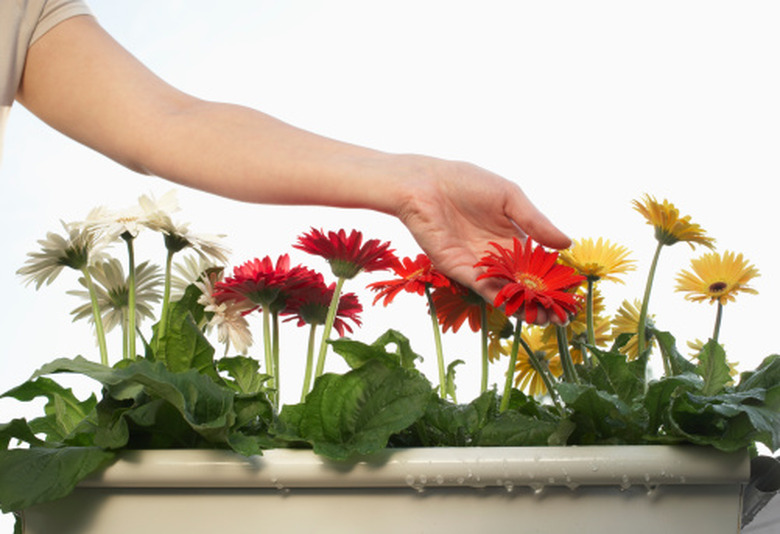Differences In Gerber Daisies & Gerbera Daisies
Also known as African daisy or Transvaal daisy, the gerber daisy (Gerbera Jamesonii) is a perennial member of the aster/daisy family characterized by a thick green stem, coarse leaves and large, brilliantly colored daisy flowers. Gerber daisies are sometimes referred to as "gerberas," in reference to the plant's genus. Numerous cultivars are available commercially in the nursery trade.
Appearance
Gerber daisies have a low growth habit, reaching heights of about a foot. The plant features a rosette of coarse, slightly hairy leaves that reach up to 10 inches in length. Flowers are 2 1/2 to 4 inches in diameter, and resemble daisies. Flowers sit on 12- to 18-inch stems, and may be pink, orange, white, yellow or red. Both single- and double-flowered varieties are widely available. Plants are typically sold while in bloom.
- Also known as African daisy or Transvaal daisy, the gerber daisy (Gerbera Jamesonii) is a perennial member of the aster/daisy family characterized by a thick green stem, coarse leaves and large, brilliantly colored daisy flowers.
- Gerber daisies have a low growth habit, reaching heights of about a foot.
Location
The gerber daisy hails from the Transvaal region of South Africa, though it's widely cultivated in warm climates across the globe. As a landscape plant, gerber daisy may be grown in USDA zones 9 to 11. The plant is tolerant of temperatures as low as 30 degrees Fahrenheit, though prolonged freezing periods will kill the plant to the roots. Gerber daisies may be grown in full sunlight or light shade, though they prefer morning sun and afternoon shade.
Culture
Gerber daisies require a well draining, deep soil that's enhanced regularly throughout the growing season with fertilizer. If grown in compact or poorly draining soils, the plant is likely to suffer from root rot. In the garden, space plants at least a foot apart to allow for proper air circulation. The flower may be propagated by seed or root division, although seeds tend to vary dramatically from one flower to the next.
- The gerber daisy hails from the Transvaal region of South Africa, though it's widely cultivated in warm climates across the globe.
- Gerber daisies may be grown in full sunlight or light shade, though they prefer morning sun and afternoon shade.
Pests
Common gerber daisy pests include leaf miners, caterpillars and cutworms. Leaf miners cause unattractive, squiggly tunnels on the foliage. Remove damaged leaves and use an insecticide if necessary to combat the problem. Caterpillars and cutworms feed on foliage and stems, causing an overall decline in plant health. Remove insects by hand, and pick off seriously damaged leaves. Spider mites may attack in hot, humid weather. Wash off insects or thoroughly spray the plant with insecticide.
- Common gerber daisy pests include leaf miners, caterpillars and cutworms.
- Remove damaged leaves and use an insecticide if necessary to combat the problem.
